lock DATSUN PICK-UP 1977 Owners Manual
[x] Cancel search | Manufacturer: DATSUN, Model Year: 1977, Model line: PICK-UP, Model: DATSUN PICK-UP 1977Pages: 537, PDF Size: 35.48 MB
Page 281 of 537

R
range
Reverse
Automatic
Transmission
TOl
QuaConverter
o
IIi
0
ou
14
Q
FI
Lu
IUt
O
Front
Lub
lc
O
lnV
ly
R
MO
V
l
Front
Clutdt
LowaoA
B
k
e
k
B
Clutch
ID
VK
n
V
lv
@
ftV
1
I
j
Throttle
O
in
V
Otlflce
Check
V
III
@lnd
3rdShih
V
zz
@
2nd
rd
TIm
If
V
Iy
Second
Lock
V
3
I
Zl
Not
M
k
d
X
er
0
1
LI
p
O
nOf
f
P
G
preau
I
J
Torqu
0
0
pr
Throttl
p
1
s
co
O
V
0
O
V
Fig
A
T
28
AT
17
Oil
pressure
circuit
diagram
n
II
range
Reverse
Page 284 of 537
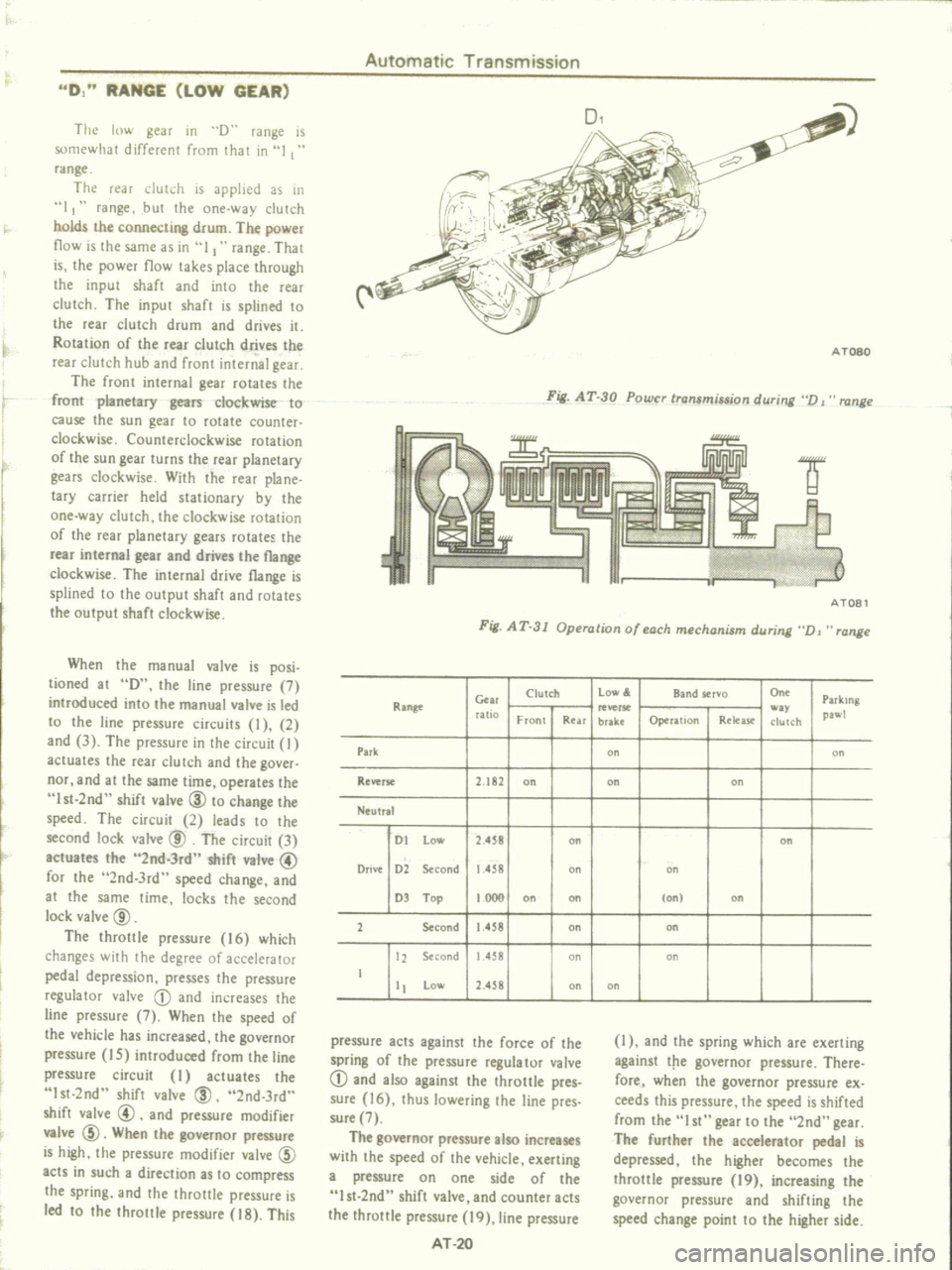
D
RANGE
LOW
GEAR
Automatic
Transmission
The
low
gear
in
D
range
is
somewhat
different
from
that
in
I
range
The
rear
c1utdl
is
applied
as
III
I
range
but
the
one
way
clutch
holds
the
connecting
drum
The
power
now
is
the
same
as
in
1
J
range
That
is
the
power
now
takes
place
through
Ihe
input
shaft
and
into
the
rear
clutch
The
input
shaft
is
splined
to
the
rear
clutch
drum
and
drives
it
Rotation
of
Ihe
rear
clutch
drives
the
rear
clutch
hub
and
front
internal
gear
The
front
internal
gear
rotales
the
front
planetary
gears
clockwise
to
cause
the
sun
gear
to
rotate
counter
clockwise
Counterclockwise
rotation
of
the
sun
gear
turns
the
rear
planetary
gears
clockwise
With
the
rear
plane
tary
carrier
held
stationary
by
the
one
way
clutch
the
clockwise
rotation
of
the
rear
planetary
gears
rotates
the
rear
internal
gear
and
drives
the
flange
clockwise
The
internal
drive
flange
is
splined
to
the
outpul
shaft
and
rotates
the
output
shaft
clockwise
When
the
manual
valve
is
posi
tioned
at
D
the
line
pressure
7
introduced
into
the
manual
valve
is
led
to
the
line
pressure
circuits
l
2
and
3
The
pressure
in
the
circuit
I
acluates
the
rear
clutch
and
the
gover
nor
and
al
the
same
time
operates
the
1st
2nd
shift
valve
CID
to
change
the
speed
The
circuit
2
leads
to
the
second
lock
valve
@
The
circuit
3
actuates
the
2nd
3rd
shift
valve
@
for
the
2nd
3rd
speed
change
and
at
the
same
lime
locks
the
second
lock
valve
@
The
throttle
pressure
16
which
changes
with
the
degree
of
accelerator
pedal
depression
presses
Ihe
pressure
regulator
valve
CD
and
increases
the
line
pressure
7
When
Ihe
speed
of
the
vehicle
has
increased
the
governor
pressure
15
introduced
from
the
line
pressure
circuit
I
actuates
the
I
SI
2nd
shift
valve
CID
2nd
3rd
shift
valve
@
and
pressure
modifier
valve
ID
When
the
governor
pressure
is
high
the
pressure
modifier
valve
ID
acls
in
such
a
direction
as
to
compress
the
spring
and
the
throttle
pressure
is
led
to
the
throttle
pressure
18
This
ATOSO
Fig
AT
30
Power
transmission
during
D
J
range
liIIl
I
IW
L
AT08l
Fig
AT
31
Operation
of
each
mechanism
during
VJ
range
Clutch
low
Band
servo
On
Parking
Cur
Ran
Rllelle
way
pawl
ratio
Front
Rur
brake
Operation
Rekase
ch
lch
Park
on
on
RellerK
2
t82
on
on
on
Neutral
01
low
2
S8
on
on
Orivt
02
Second
1
458
on
on
OJ
Top
1000
on
on
on
on
2
Second
1
458
on
00
t2
Second
1
458
on
on
t
tt
low
2
458
on
on
pressure
acts
against
the
force
of
the
spring
of
the
pressure
regulator
valve
CD
and
also
against
the
throttle
pres
sure
16
thus
lowering
the
line
pres
sure
7
The
governor
pressure
also
increases
with
the
speed
of
Ihe
vehicle
exerting
a
pressure
on
one
side
of
the
lst
2nd
shift
valve
and
counter
acts
the
Ihrottle
pressure
19
line
pressure
AT
20
l
and
the
spring
which
are
exerting
against
t
1e
governor
pressure
There
fore
when
the
governor
pressure
ex
ceeds
Ihis
pressure
the
speed
is
shifted
from
the
I
st
gear
to
the
2nd
gear
The
further
the
accelerator
pedal
is
depressed
the
higher
becomes
the
throttle
pressure
19
increasing
the
governor
pressure
and
shifting
the
speed
change
point
to
the
higher
side
Page 286 of 537
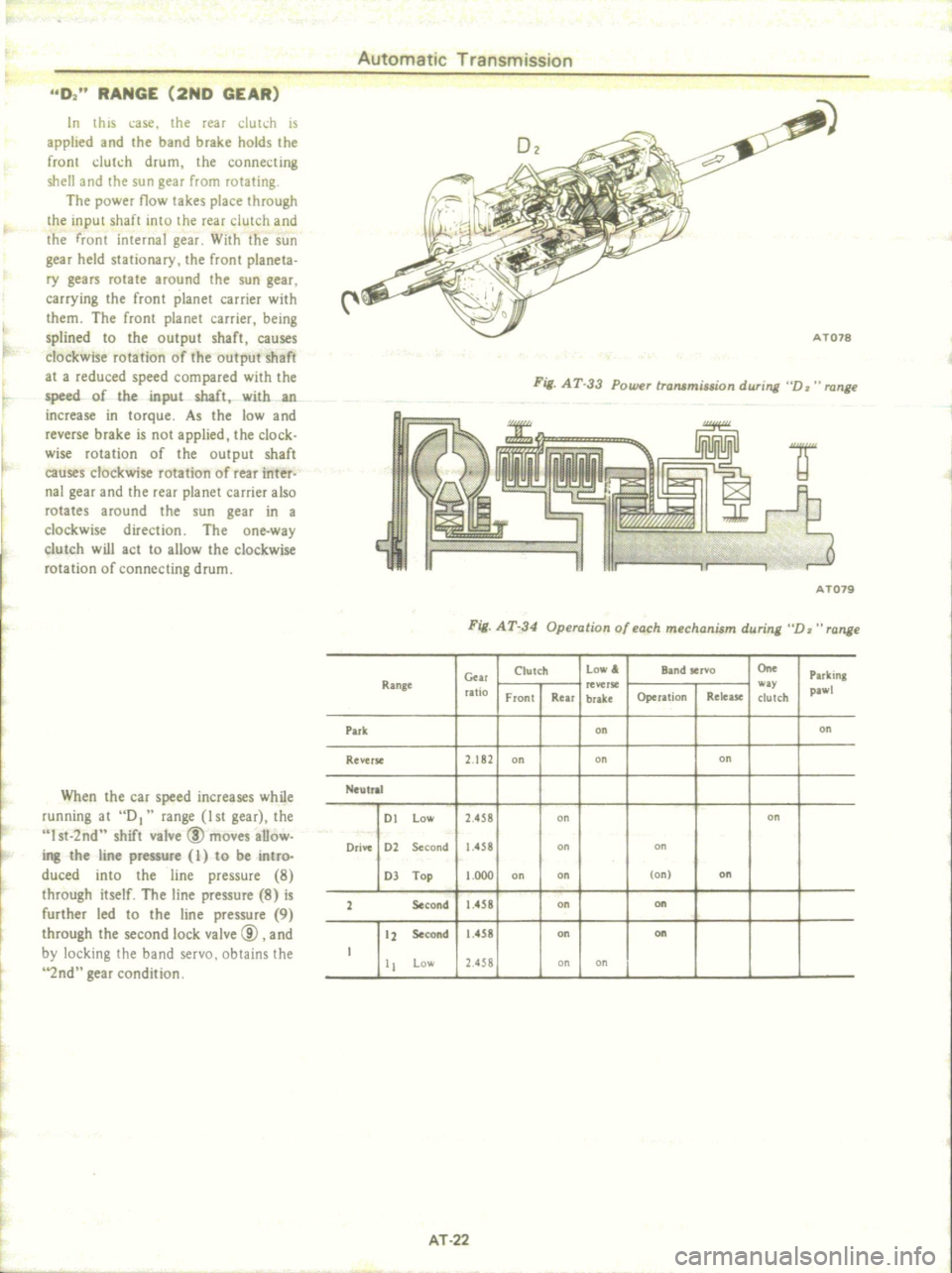
D
RANGE
2ND
GEAR
Automatic
Transmission
t
In
this
case
the
rear
c1ut
h
IS
applied
and
the
band
brake
holds
the
fronl
dUh
h
drum
the
connecting
shell
and
the
sun
gear
from
rotating
The
power
flow
lakes
place
through
the
input
shaft
into
the
rear
clutch
and
the
front
internal
gear
With
the
sun
gear
held
stationary
the
front
planeta
ry
gears
rotate
around
the
sun
gear
carrying
the
front
planet
carrier
with
them
The
fronl
planet
carrier
being
splined
to
the
output
shaft
causes
clockwise
rotation
of
the
output
shaft
at
a
reduced
speed
compared
with
the
speed
of
the
input
shaft
with
an
increase
in
torque
As
the
low
and
reverse
brake
is
not
applied
the
clock
wise
rotation
of
the
output
shaft
causes
clockwise
rotation
of
rear
inter
nal
gear
and
the
rear
planet
carrier
also
rotates
around
the
sun
gear
in
a
clockwise
direction
The
one
way
clutch
will
act
to
allow
the
clockwise
rotation
of
connecting
drum
When
the
car
speed
increases
while
running
at
D
range
I
st
gear
the
st
2nd
shift
valve
ID
moves
allow
ing
the
line
pressure
I
to
be
intro
duced
into
the
line
pressure
8
Ihrough
itself
The
line
pressure
8
is
further
led
to
the
line
pressure
9
through
the
second
lock
valve
@
and
by
locking
the
band
servo
obtains
the
2nd
gear
condition
Fig
AT
33
Power
transmission
during
Dz
range
A
T079
Fig
AT
34
Operation
of
each
mechanism
during
D
range
Clutch
Low
Band
servo
On
Patking
G
Range
reverse
w
pawl
ratio
Fronl
Rur
brake
Optrltion
Release
clutch
PlIk
on
on
Revtne
2
182
on
on
on
Neutral
01
Low
2
4S8
on
on
Drive
02
Second
1
4S8
on
on
OJ
Top
1
000
on
on
on
on
2
Second
1
4S8
on
on
12
Second
1
4S8
on
on
1
II
Low
2
4S8
on
on
AT
22
Page 292 of 537
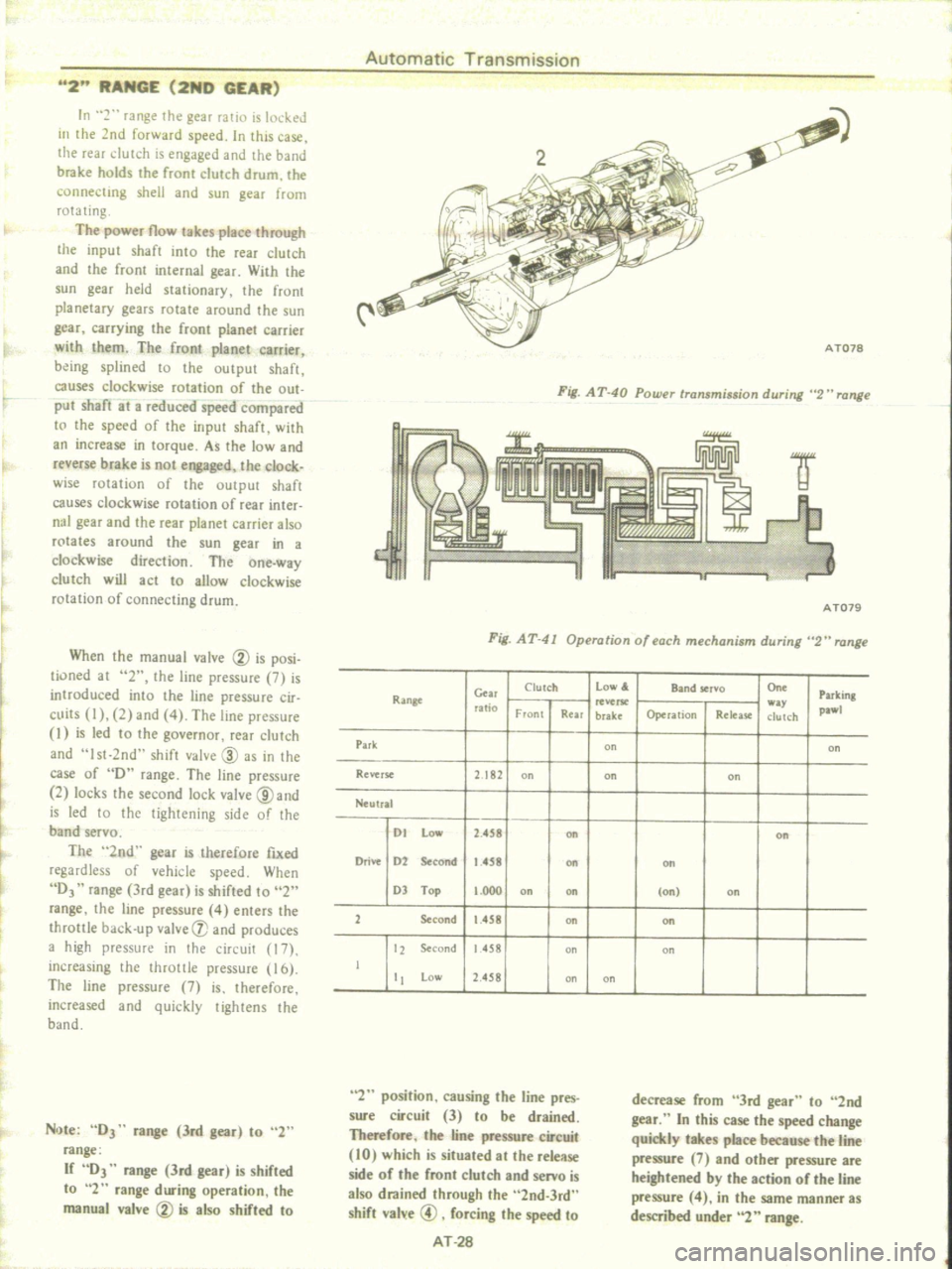
2
RANGE
2ND
GEAR
Automatic
Transmission
In
2
range
the
gear
rario
is
IOI
keJ
III
the
2nd
forward
speed
In
this
case
the
rear
dutch
is
engaged
and
the
band
brake
holds
the
front
clutch
drum
the
connecting
shell
and
sun
gear
from
rotating
The
power
flow
takes
place
through
the
input
shaft
inlo
the
rear
clutch
and
the
front
internal
gear
With
Ihe
sun
gear
held
stationary
the
front
planetary
gears
rotate
around
the
sun
gear
carrying
the
front
planet
carrier
with
them
The
front
planet
carrier
being
splined
to
the
output
shaft
causes
clockwise
rotation
of
the
OUI
put
shaft
at
a
reduced
speed
compared
to
the
speed
of
the
input
shaft
with
an
increase
in
torque
As
the
low
and
reverse
brake
is
not
engaged
the
clock
wise
rotation
of
the
output
shaft
causes
clockwise
rotation
of
fear
inter
nal
gear
and
the
rear
planet
carrier
also
rotates
around
the
sun
gear
in
a
clockwise
direction
The
one
way
clutch
will
act
to
allow
clockwise
rotation
of
connecting
drum
When
the
manual
valve
V
is
posi
tioned
at
2
the
line
pressure
7
is
introduced
into
the
line
pressure
cir
cuits
I
2
and
4
The
line
pressure
I
is
led
to
the
governor
rear
clutch
and
I
st
2nd
shift
valve
CID
as
in
the
case
of
D
range
The
line
pressure
2
locks
the
second
lock
valve
@and
is
led
to
thc
tightening
side
of
Ihe
band
servo
The
2nd
gear
is
therefore
fixed
regardless
of
vehicle
speed
When
DJ
range
3rd
gear
is
shifted
to
2
range
the
line
pressure
4
enters
Ihe
throttle
back
up
valve
V
and
produces
a
high
pressure
in
the
circuit
17
increasing
thc
throttle
pressure
li
6
The
line
pressure
7
is
therefore
increased
and
quickly
tightens
the
band
N
e
DJ
range
3rd
gear
to
2
range
If
DJ
range
3rd
gear
is
shifled
to
2
range
during
operation
the
manual
valve
V
is
also
shifted
to
A
T078
Fig
AT
40
Powu
tTansminion
during
2
H
range
A
1079
Fig
AT
41
Operation
of
each
mechanism
during
2
range
Clutch
Low
Band
ser
o
On
Parking
Gw
Ran8t
utio
w
pa
Front
Rear
brake
Operalion
Release
dutch
Pui
on
on
Revtrs
e
2
182
on
on
on
Neutral
01
Low
2
458
on
on
Drive
02
Second
1
458
Oft
Oft
OJ
Top
1
000
on
on
on
on
1
Second
1
458
on
Oft
12
tocond
1458
on
on
J
tt
Low
2
458
on
on
2
position
causing
the
line
pres
sure
circuit
3
to
be
drained
Therefore
the
line
pressure
circuit
10
which
is
situated
at
the
release
side
of
the
front
clutch
and
servo
is
also
drained
through
the
2nd
3rd
shift
val
e
@
forcing
the
speed
to
AT
28
decrease
from
3rd
gear
to
2nd
gear
In
this
case
the
speed
change
quickly
takes
place
because
the
line
pressure
7
and
other
pressure
are
heightened
by
the
action
of
the
line
pressure
4
in
the
same
manner
as
described
under
2
range
Page 293 of 537

Automatic
Transmission
2
range
2nd
gear
Torqu
Con
Fron
Clutch
l
ow
A
B
ke
Br
I
12
011
Cool
i
IL
12
ID
v
Th
ot
Valve
7
T
onl
Beck
up
V
ID
So
0
Id
1ft
v
Front
Lubric
t
Orltic
Check
Va
Or
lnVal
e
Throttle
Dr
in
V
l
P
Modif
Va
15
BJl
@
2nct
3rd
Tim
If
Ve
12
3
1
2nd
Stolt
21
Se
onc
l
Lock
Va
3
I
PR
02
1
s
I
Jl
J
I
r
A
ul
Gr
v
2
w
Valve
Note
Merltedl
D
a
n
I
G
v
Line
p
IOo
nOf
f
d
pr
G
no
p
r
c
o
Torque
con
pr
Thron
p
re
ond
a
nor
v
Fig
A
T
42
Oil
pressure
circuit
diagram
2
range
2nd
gear
AT
29
Page 294 of 537
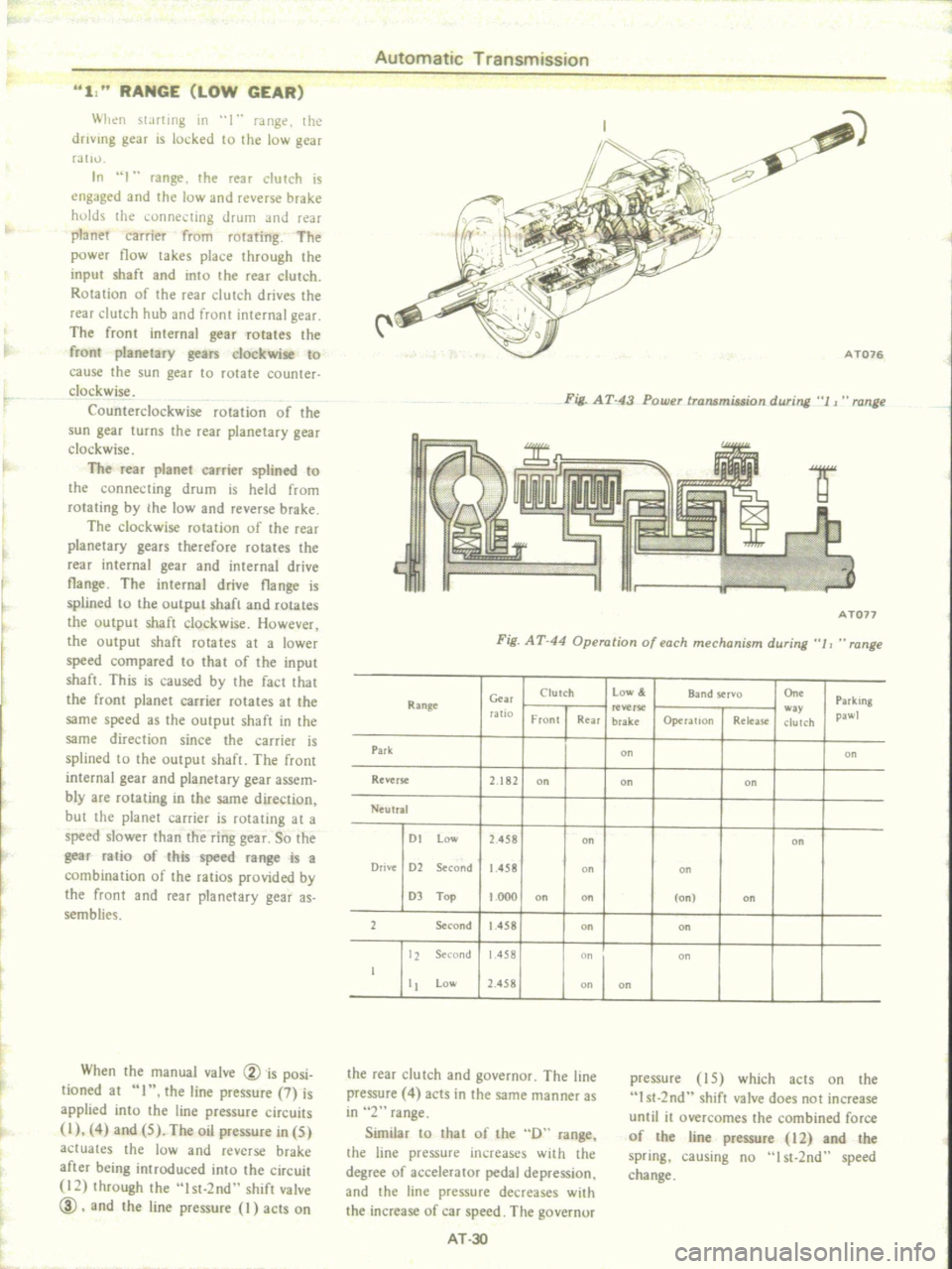
1
RANGE
LOW
GEAR
Automatic
Transmission
f
Wilen
slJrting
in
I
range
the
drlvlIlg
gear
is
IOl
ked
to
the
low
gear
fJIIIJ
In
H
range
the
rear
clutch
is
engJged
and
the
low
and
reverse
brake
hulds
he
onnecting
drum
and
feac
planet
carrier
from
rotating
The
power
tlow
lakes
place
through
the
input
shaft
and
into
lhe
rear
clutch
ROlalion
of
the
rear
clutch
drives
lhe
rear
dutch
hub
and
front
internal
gear
The
front
internal
gear
rotates
the
front
planetary
gears
clockwise
to
cause
the
sun
gear
to
rotate
counter
clockwise
Counterclockwise
rotation
of
the
sun
gear
turns
the
rear
planetary
gear
clockwise
The
rear
planet
carrier
splined
to
the
connecting
drum
is
held
from
rotating
by
the
low
and
reverse
brake
The
clockwise
rotation
of
the
rear
planetary
gears
therefore
rotates
the
rear
internal
gear
and
internal
drive
tlange
The
internal
drive
tlange
is
splined
to
the
output
shaft
and
rotates
the
uutput
shaft
clockwise
However
the
output
shaft
rotates
at
a
lower
speed
compared
to
that
of
the
input
shaft
This
is
caused
by
the
fact
Ihat
the
front
planet
carrier
rotates
at
the
same
speed
as
Ihe
OUlput
shaft
in
the
same
direction
since
the
carrier
is
splined
to
the
output
shaft
The
front
internal
gear
and
planetary
gear
assem
bly
are
rotating
in
the
same
direction
but
the
planet
carrier
is
rotating
at
a
speed
slower
than
the
ring
gear
So
the
gear
ralio
of
this
speed
range
is
a
combination
of
the
ratios
provided
by
the
front
and
rear
planetary
gear
as
semblies
When
the
manual
valve
Vis
posi
tioned
at
I
the
line
pressure
7
is
applied
into
the
line
pressure
circuits
I
4
and
5
The
oil
pressure
in
5
actuates
the
luw
and
reverse
brake
after
being
introduced
into
the
circuit
12
through
Ihe
1st
2nd
shift
valve
ID
and
the
line
pressure
I
acts
on
C
A
T076
Fig
AT
43
Power
transmission
during
1
J
range
Fai1
A
TOn
Fig
AT
44
Operation
of
each
mechanism
during
JJ
range
Clutch
Low
Band
servo
On
Parking
Gm
Range
reverse
w
pawl
ratIO
Front
Rur
brake
Operatlon
Release
clulCh
Park
on
on
Reverse
2
182
on
on
on
Neutral
01
low
2
458
on
on
Drive
02
Second
1
458
on
on
03
Top
1000
on
on
on
on
2
Second
1
458
on
on
2
Second
IAS8
on
on
I
1
low
2
458
on
on
the
rear
clutch
and
governor
The
line
pressure
4
acts
in
the
same
manner
as
in
2
range
Similar
to
that
of
the
D
range
the
line
pressure
inr
reases
with
the
degree
of
accelerator
pedal
depression
and
the
line
pressure
decreases
with
the
increase
of
car
speed
The
governor
pressure
15
which
acts
on
the
I
st
2nd
shift
valve
does
not
increase
until
it
overcomes
the
combined
force
of
the
line
pressure
12
and
the
spring
causing
no
st
2nd
speed
cha
nge
AT
30
Page 297 of 537
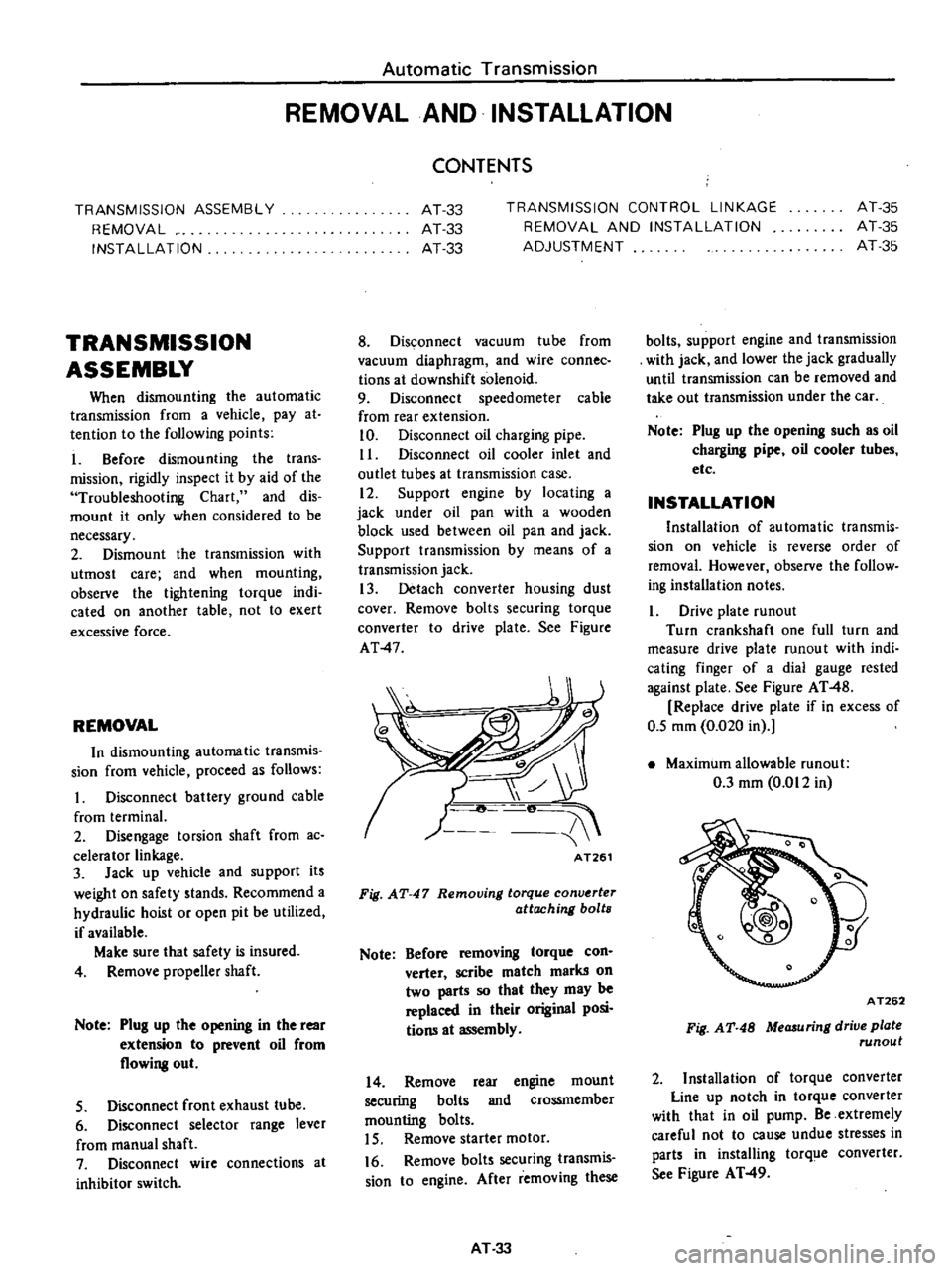
Automatic
Transmission
REMOVAL
AND
INSTALLATION
TRANSMISSION
ASSEMBLY
REMOVAL
INSTALLATION
TRANSMISSION
ASSEMBLY
When
dismounting
the
automatic
transmission
from
a
vehicle
pay
at
tention
to
the
following
points
1
Before
dismounting
the
trans
mission
rigidly
inspecl
it
by
aid
of
the
Troubleshooting
Chart
and
dis
mount
it
only
when
considered
to
be
necessary
2
Dismount
the
transmission
with
utmost
care
and
when
mounting
observe
the
tightening
torque
indi
cated
on
another
table
not
to
exert
excessive
force
REMOVAL
In
dismounting
automatic
transmis
sion
from
vehicle
proceed
as
follows
I
Disconnect
battery
ground
cable
from
terminal
2
Disengage
torsion
shaft
from
ac
celerator
linkage
3
Jack
up
vehicle
and
support
its
weight
on
safety
stands
Recommend
a
hydraulic
hoist
or
open
pit
be
utilized
if
available
Make
sure
that
safety
is
insured
4
Remove
propeller
shaft
Note
Plug
up
the
opening
in
the
rear
extension
to
prevent
oil
from
flowing
out
5
Disconnect
front
exhaust
tube
6
Disconnect
selector
range
lever
from
manual
shaft
7
Disconnect
wire
connections
at
inhibitor
switch
CONTENTS
AT
33
AT
33
AT
33
TRANSMISSION
CONTROL
LINKAGE
REMOVAL
AND
INSTALLATION
ADJUSTMENT
AT
35
AT
35
AT
35
8
Disconnect
vacuum
tube
from
vacuum
diaphragm
and
wire
connee
lions
at
downshift
solenoid
9
Disconnect
speedometer
cable
from
rear
extension
10
Disconnect
oil
charging
pipe
II
Disconnect
oil
cooler
inlet
and
outlet
tubes
at
transmission
case
12
Support
engine
by
locating
a
jack
under
oil
pan
with
a
wooden
block
used
between
oil
pan
and
jack
Support
transmission
by
means
of
a
transmission
jack
13
Detach
converter
housing
dust
cover
Remove
bolts
securing
torque
converter
to
drive
plate
See
Figure
AT
4
AT261
Fig
AT
47
Removing
torque
conv
rter
attaching
bolts
Note
Before
removing
torque
con
verter
scribe
match
marks
on
two
parts
so
that
they
may
be
replaced
in
their
original
posi
tions
at
assembly
14
Remove
rear
engine
mount
securing
bolts
and
crossmember
mounting
bolts
15
Remove
starter
motor
16
Remove
bolts
securing
transmis
sion
to
engine
After
removing
these
AT
33
bolts
support
engine
and
transmission
with
jack
and
lower
the
jack
gradually
until
transmission
can
be
removed
and
take
out
transmission
under
the
car
Note
Plug
up
the
opening
such
as
oil
charging
pipe
oil
cooler
tubes
etc
INSTALLATION
Installation
of
automatic
transmis
sion
on
vehicle
is
reverse
order
of
removal
However
observe
the
follow
ing
installation
notes
Drive
plate
runout
Turn
crankshaft
one
full
turn
and
measure
drive
plate
mnou
t
with
indi
cating
finger
of
a
dial
gauge
rested
against
plate
See
Figure
AT
48
Replace
drive
plate
if
in
excess
of
0
5
mm
0
020
in
Maximum
allowable
mnout
0
3
mm
0
012
in
A
T262
Fig
AT
48
MeCJ
uring
drive
plate
runout
2
Installation
of
torque
converter
Line
up
notch
in
torque
converter
with
that
in
oil
pump
Be
extremely
careful
not
to
cause
undue
stresses
in
parts
in
installing
torq
e
converter
See
Figure
AT
49
Page 300 of 537
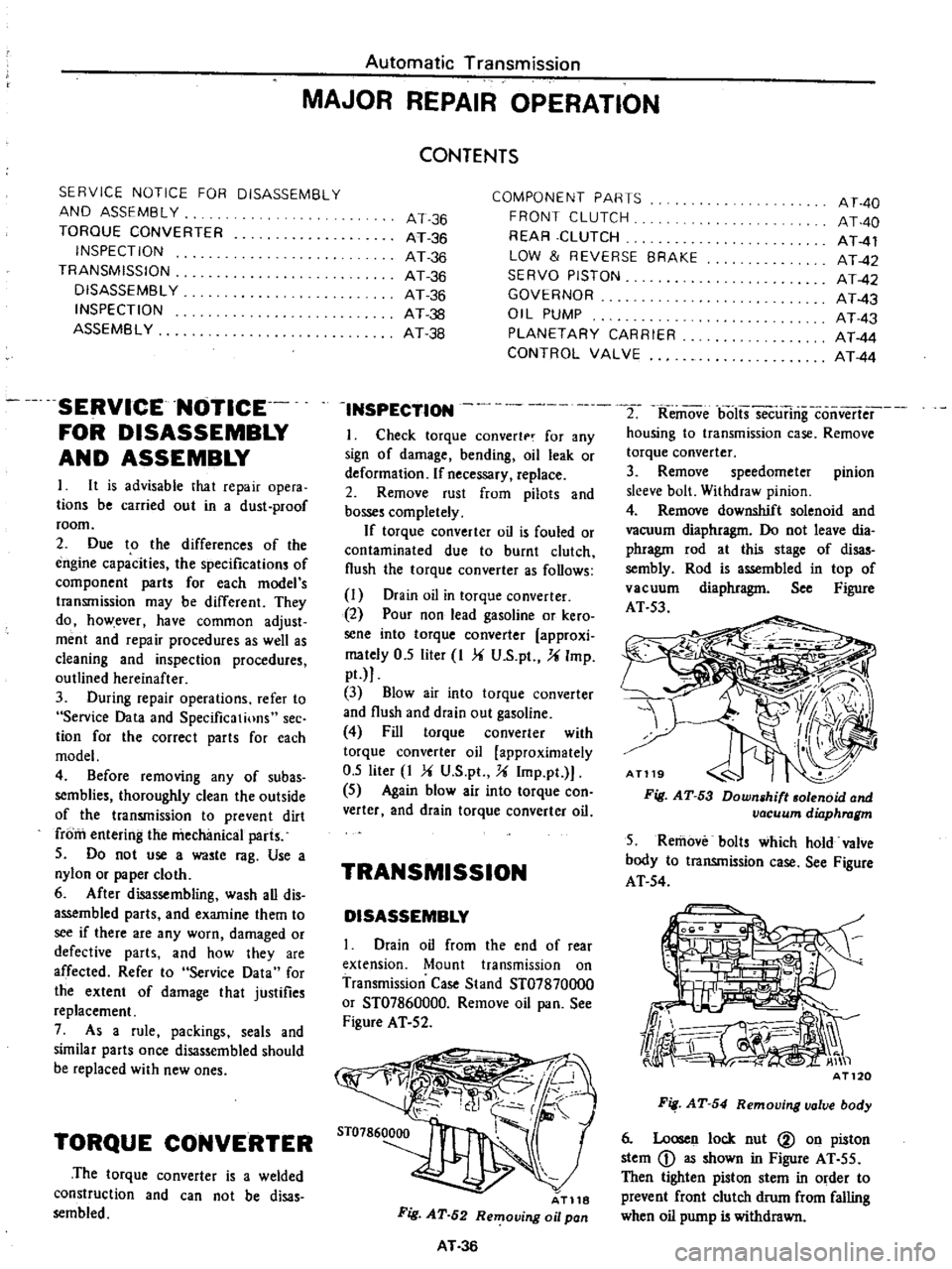
Automatic
Transmission
MAJOR
REPAIR
OPERATION
SERVICE
NOTICE
FOR
DISASSEMBLY
AND
ASSEMBLY
TORQUE
CONVERTER
INSPECTION
TRANSMISSION
DISASSEMBL
Y
INSPECTION
ASSEMBL
Y
SERVICE
NOTICE
FOR
DISASSEMBLY
AND
ASSEMBLY
I
It
is
advisable
that
repair
opera
tions
be
carried
out
in
a
dust
proof
room
2
Due
to
the
differences
of
the
engine
capacities
the
specifications
of
component
parts
for
each
model
s
transmission
may
be
different
They
do
however
have
common
adjust
ment
and
repair
procedures
as
well
as
cleaning
and
inspection
procedures
outlined
hereinafter
3
During
repair
operations
refer
to
Service
Data
and
Specifications
see
tion
for
the
correct
parts
for
each
model
4
Before
removing
any
of
subas
semblies
thoroughly
clean
the
outside
of
the
transmission
to
prevent
dirt
from
entering
the
mechanical
parts
5
Do
not
use
a
waste
rag
Use
a
nylon
or
paper
cloth
6
After
disassembling
wash
all
dis
assembled
parts
and
examine
them
to
see
if
there
are
any
worn
damaged
or
defective
parts
and
how
they
are
affected
Refer
to
Service
Data
for
the
extent
of
damage
that
justifies
replacement
7
As
a
rule
packings
seals
and
similar
parts
once
disassembled
should
be
replaced
with
new
ones
TORQUE
CONVERTER
The
torque
converter
is
a
welded
construction
and
can
not
be
disas
sembled
CONTENTS
AT
36
AT
36
AT
36
AT
36
AT
36
AT
38
AT
38
COMPONENT
PARTS
FRONT
CLUTCH
REAR
CLUTCH
LOW
REVERSE
BRAKE
SERVO
PISTON
GOVERNOR
OIL
PUMP
PLANETARY
CARRIER
CONTROL
VALVE
AT
40
AT
40
AT
41
AT
42
AT
42
AT
43
AT
43
AT
44
AT
44
INSPECTION
2
Remove
bolts
securing
converter
1
Check
torque
convertf
for
any
housing
to
transmission
case
Remove
sign
of
damage
bending
oil
leak
or
torque
converter
deformation
If
necessary
replace
3
Remove
speedometer
pinion
2
Remove
rust
from
pilots
and
sleeve
bolt
Withdraw
pinion
bosses
completely
4
Remove
downshift
solenoid
and
If
torque
converter
oil
is
fouled
or
vacuum
diaphragm
Do
not
leave
dia
contaminated
due
to
burnt
clutch
phragm
rod
at
this
stage
of
disas
flush
the
torque
converter
as
follows
sembly
Rod
is
assembled
in
top
of
vacuum
diaphragm
See
Figure
I
Drain
oil
in
torque
converter
AT
53
2
Pour
non
lead
gasoline
or
kero
sene
into
torque
converter
approxi
mately
0
5
liter
I
U
S
pt
U
Imp
pt
3
Blow
air
into
torque
converter
and
flush
and
drain
out
gasoline
4
Fill
torque
converter
with
torque
converter
oil
approximately
0
5
liter
I
V
S
pt
U
Imp
pt
5
Again
blow
air
into
torque
con
verter
and
drain
torque
converter
oil
TRANSMISSION
DISASSEMBLY
I
Drain
oil
from
the
end
of
rear
extension
Mount
transmission
on
Transmission
Case
Stand
ST07870000
or
ST07860000
Remove
oil
pan
See
Figure
AT
52
AT118
Fig
AT
52
Removing
oil
pan
AT
36
Fig
AT
53
Down
hilt
olenoid
and
vacuum
dilJphragm
5
Remove
bolts
which
hold
valve
body
to
transmission
case
See
Figure
AT
54
Fig
AT
54
Removing
valve
body
6
Loosen
lock
nut
@
on
piston
stem
D
as
shown
in
Figure
AT
55
Then
tighten
piston
stem
in
order
to
prevent
front
clutch
drum
from
falling
when
oil
pump
is
withdrawn
Page 302 of 537

I
i
0
t
V
iL
1
0
ST25570001
j
w
1
h
AT130
Fig
AT
64
Removing
hex
head
slotted
bolt
19
Blowout
low
and
reverse
brake
piston
by
directing
a
jet
of
air
into
holeJn
cylinder
See
F
igure
AT
65
Fig
AT
65
Removing
piston
20
Remove
band
servo
loosening
attaching
bolts
Note
If
difficulty
is
encountered
in
removing
retainer
direct
a
jet
of
air
toward
release
side
as
shown
in
Figure
AT
66
II
AP
fW
l
1
A
T132
Fig
AT
fiB
Removing
bond
servo
21
Pry
snap
rings
CD
from
both
ends
of
parking
brake
lever
@
and
remove
the
lever
Back
off
manual
shaft
lock
nut
ID
and
remove
manual
plale
@
and
parking
rod
CID
See
Figure
AT
67
Automatic
Transmission
Up
@
J1i
ll
J
t
i
p
lli
l
1
I
l
P
l
1
Ii
@
j
Y
L
l
rr
i
J
ry
j
AT133
Fig
AT
67
Removing
manual
plate
22
Remove
inhibitor
switch
and
manual
shaft
by
loosening
two
secur
ing
bolts
INSPECTION
Torque
c
onverter
housing
transmission
c
ase
and
rear
extension
I
Check
for
damage
or
cracking
if
necessary
replace
2
Check
for
dents
or
score
marks
on
mating
surfaces
Repair
as
nee
essary
3
If
rear
extension
bushing
is
worn
or
cracked
replace
it
as
an
assembly
of
bushing
and
rear
extension
housing
Gaskets
and
O
ring
1
Always
use
new
gaskets
when
the
units
are
to
be
disassembled
2
Check
O
rings
for
burrs
or
crack
ing
If
necessary
replace
with
new
rings
011
distributor
I
Check
for
signs
of
wear
on
seal
ring
and
ring
groove
replacing
with
new
ones
if
found
worn
beyond
use
Check
that
clearance
between
seal
ring
and
ring
groove
is
correct
If
out
of
specification
replace
whichever
is
worn
beyond
limits
Correct
clearance
is
from
0
04
to
0
16
mm
0
0016
to
0
0063
in
See
Figure
AT
68
AT
J8
j
Clearance
1
61
Seal
dng
0
j
J
I
I
AT134
ig
A
r
68
Me
q
sur
ingseal
r
ing
to
ring
groove
clearance
ASSEMBLY
Assembly
is
in
reverse
order
of
disassembly
However
observe
the
fol
lowing
assembly
notes
After
installing
piston
of
low
and
reverse
orake
assemble
thrust
spring
ring
return
spring
thrust
washer
and
one
way
clutch
inner
race
Torque
hex
head
slotted
bolt
to
L3to
1
8
kg
m
9
to
13
ft
ib
using
Hex
head
Ex
tension
ST2SS7000
ST2SS70000
Torque
Wrench
GG93010000
and
Socket
Extension
ST2S490000
ST2SS
12001
See
Figure
AT
69
ST2557000t
ST25490000
I
GG930JOOOO
A
T135
Fig
AT
69
Installing
ont
woy
clutch
inner
race
2
After
low
and
reverse
brake
has
been
assembled
measure
the
clearance
between
snap
ring
CD
and
retaining
plate
@
Select
proper
thickness
of
retaining
plate
to
give
correct
ring
to
plate
clearance
See
Figure
AT
70
Low
and
reverse
brake
clearance
0
80
to
1
05
rom
0
0315
to
0
0413
in
Page 303 of 537

Fig
AT
70
Measuring
ring
to
plate
clearance
Available
retaining
plate
Thickness
mm
in
1l
8
0
465
12
0
0472
12
2
0480
124
0488
12
6
0496
12
8
0
504
For
inspection
procedure
for
low
and
reverse
brake
see
page
AT
42
for
Assembly
3
Install
one
way
clutch
so
that
the
arrow
mark
is
toward
front
of
vehicle
It
should
be
free
to
rotate
only
in
clockwise
direction
See
Figure
AT
71
mITIJ
o
oml
AT137
Fig
AT
71
One
way
clutch
4
After
installing
rear
extension
torque
attaching
bolts
to
2
0
to
2
5
kg
m
14
to
18
ft
lb
Place
manual
lever
in
P
range
and
check
to
be
sure
that
rear
output
shaft
is
securely
blocked
5
Tighten
servo
retainer
temporari
ly
at
this
stage
of
assembly
6
Place
rear
clutch
assembly
with
needle
bearing
on
front
assembly
Automatic
Transmission
7
Install
rear
clutch
hub
and
front
planetary
carrier
as
shown
in
Figure
AT
72
AT142
Fig
AT
72
Installing
planetary
carrier
8
Assemble
connecting
shell
and
other
parts
up
to
front
Clutch
in
reverse
order
of
disassembly
AT143
Fig
AT
73
Installing
connecting
shell
9
Adjust
total
end
play
and
front
end
playas
follows
Front
end
play
L
r
L
CD
I
r
L
11
I
J
Total
end
play
@
Front
clutch
thrust
washer
2
Oil
pump
cover
3
Front
clutch
4
Rear
clutch
AT138
5
Trammission
case
6
Oil
pump
gasket
7
Oil
pump
cover
bearing
race
Fig
AT
74
End
play
1
Measure
the
distance
A
and
C
by
vernier
calipers
as
shown
in
Figure
AT
75
AT
39
i
Rear
c
clutch
N
edle
bearing
Bearing
race
I
Fig
AT
75
AT139
Measuring
the
distance
A
and
C
2
Measure
the
distance
B
and
D
of
oil
pump
cover
as
shown
in
Figure
AT
76
I
L
I
Oiipi
mp
AT140
Fig
AT
76
Measuring
the
distance
B
and
D
Adjustment
of
total
end
play
Select
oil
pump
cover
bearing
race
by
calculating
the
following
formula
TT
A
B
W
where
T
T
Required
thickness
of
oil
pump
cover
bearing
race
mm
in
A
Measured
distance
A
mm
in
B
Measured
distance
B
mm
in
W
Thickness
of
bearing
race
temporarily
inserted
mm
in
Available
oil
pump
cover
bearing
race
Thickness
mm
in
1
2
0
047
I
4
0
055
1
6
0
063
1
8
0
071
2
0
0
079
2
2
0
087
Specified
total
end
play
0
25100
50
mm
0
0098
to
0
0197
in